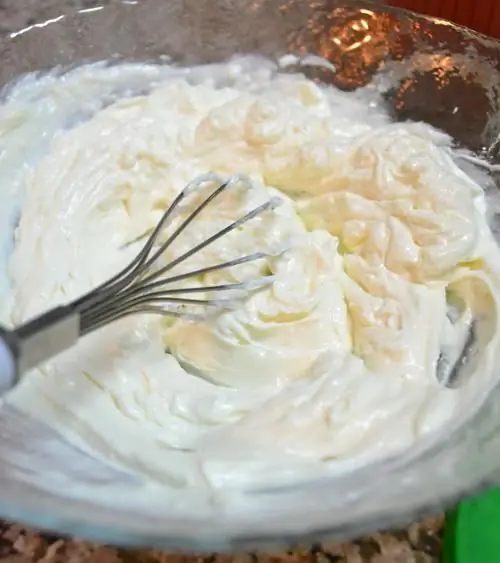2026 Author: Isabella Gilson | [email protected]. Last modified: 2025-01-23 12:50:50
Confectionery mastic is loved by all cooks for its plasticity and beauty. Mastic allows you to create real works of art from simply delicious cakes. From it you can sculpt, like from plasticine or clay, figures of people and animals, castles and palaces, flowers and butterflies.

Only unlike plasticine, mastic is edible - it is made on the basis of powdered sugar and condensed milk. To decorate confectionery masterpieces, mastic of different colors and shades is needed. How to paint mastic at home?
Home coloring
To create confectionery, you can purchase ready-made multi-colored mastic in the store. But you can try to do everything yourself, using various methods and substances. There are two main options for how to paint mastic and get excellent material for creativity:
- using natural juices, decoctions;
- using industrial dyes.

To create a color, you canuse products that are in every home. These can be vegetables (beets, carrots), fruits and berries (orange, strawberries, raspberries, cherries, currants), strong tea or coffee, spices (saffron, curry, turmeric).
Industrial dyes are also widely represented on the market. Among them are natural and synthetic substances.
When choosing a dye, you need to remember that natural juices give a less saturated color and can give a smack of a certain product to the mastic. Store-bought dyes are used in less quantity and produce a vibrant, rich color.
Using natural dyes
As you know, the variety of shades is obtained by mixing three original colors: red, yellow and blue. How to paint mastic using ordinary products? To get a red color, you can cook beetroot broth or berry juice from raspberries, cherries, pomegranates, strawberries. In this case, fruits or vegetables are cut, boiled in acidified water and the juice is squeezed out. The resulting liquid can be used in the process of making mastic, then the color will be richer. Yellow color will give spices or lemon zest. To do this, saffron, curry or turmeric must be diluted in a small amount of vodka or alcohol. A decoction of leafy greens, such as spinach, will give a beautiful green color. You can also just mix yellow and blue paint. The blue color is obtained by mixing starch with indigo root. If you take coffee or chocolate, you can get a nice brown tint. All other color solutions can be achieved by mixing primary colors.

Natural-based food colorings are available at the store, but tend to be quite expensive.
Liquid industrial dyes
Liquid dyes are synthetic and water-based. They can be used both for coloring the finished mastic, and for an aqueous solution for its preparation. The color of the mastic in this case may not be very bright.
Gel synthetic dyes
The substances of this group have a thicker consistency. How to paint the mastic with dye in this case? The gels are easy to use and are well suited for beginner pastry chefs.

A small amount of paint (literally a little bit) must be diluted in a small amount of water or vodka, mixed with a piece of mastic, then kneaded into the bulk until color uniformity is obtained. Gel dyes are convenient for decorating small details of a confectionery masterpiece or creating holiday inscriptions. For these purposes, you can buy special felt-tip pens with an edible composition.
Dry food colors
How to paint mastic when there are ready-made figurines and decoration elements? Dry synthetic paints work well, which can simply be applied to the surface with a soft brush and get an intense bright color. There are powders with the effect of glossy shine, golden shimmer or mother-of-pearl. This coloring is often used when creating wedding cakes. How to paint mastic with dry dyescompletely?

Like other types of food coloring, the powder must be thoroughly mixed until a homogeneous mass is obtained. Or you can use a wooden stick (for example, a toothpick). It must be placed several times, first in the coloring powder, and then in the mastic. Then knead the sweet mass. The process may take quite a long time depending on the desired result.
How to paint mastic correctly?
There are general rules for working with sweet mastic when coloring. How to color mastic to get a real work of confectionery art? In the process of selecting shades, it is useful to use a color table, it will help not to make mistakes in the original colors. Also, to determine the ideal proportions of the components, it is better to try a new color on a small piece. When introducing a dye into a sweet mass, it is necessary to knead it thoroughly in order to obtain an even beautiful color. But if you want to get mastic with interesting streaks, a slightly different technology is used. After each introduction of the dye, the edges of the plastic mass are wrapped and continue to knead. During operation, the mastic should remain soft. With the laborious process of creating individual figures, it is better to take small portions, wrapping the bulk in cling film. It is also important to remember about the saturation of color, depending on which project the confectioner decided to bring to life. Although homemade natural dyes will give calmer shades, this is not a disadvantage. Pleasant pastel colors and fullsafety of use are perfect for children's cakes. Synthetic dyes are also not hazardous to he alth and will make it possible to realize the wildest dreams.
The skill of a confectioner is akin to the art of an artist or a sculpture. Of course, a beginner has a lot to learn: how to make a biscuit or cake layers, how to brew a delicious cream, how to paint mastic, how to create a multi-tiered masterpiece and many other secrets. But as a result of these efforts, a person masters a beautiful, festive and tasty art.
Recommended:
How to paint moonshine: rules and tips

How to paint over moonshine so that there is no unpleasant smell. The most popular recipes using walnuts and pine nuts, berries, nettles, St. John's wort, orange peels, tea, coffee, prunes and so on. How to improve the color of moonshine
Home breweries: reviews. Home mini-brewery. Home Brewery: Recipes

What makes homebreweries so good? Reviews of those who have already used these machines for making beer, various important nuances and advantages of such an acquisition - all this can be read in the text below
Mastic - what is it? Mastic preparation. How to make mastic at home

Mastic decorations always evoke special delight among gourmets. What is not fashioned from it! And medieval castles, and noble frigates, and figurines of fabulous creatures. Let's see how this magnificence is done
Mastic from condensed milk. Milk mastic on condensed milk. Mastic with condensed milk - recipe

You can, of course, go to the store and buy ready-made cake decorations from marshmallows, glucose and glycerin. But, firstly, all these garlands, beads and bows with flowers do not bear a trace of your individuality and creative imagination, and secondly, they are not cheap. Therefore, today we will learn how to make mastic from condensed milk
How to paint eggs for Easter with your own hands?

February is here! Let's celebrate Maslenitsa, eat pancakes, and then it's time to prepare for Easter! That is why in the article we will find out how to paint eggs for Easter. After all, the tradition of painting eggs has been around for a very long time. And in the abundance of options, you can get confused

